
Ducati Diavel Service Manual: Refitting the exhaust system
Refit the heat guard on the manifold (10) by tightening the nuts (9) to a torque of 10 nm +/- 10% (sect. 3 - 3, Frame torque settings).
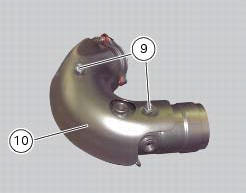
Position the vertical exhaust manifold (22) on the vertical cylinder head with the gasket (23).
Tighten the fixing nuts (21) to a torque of 10 nm +/- 10% (sect. 3 - 3, Frame torque settings).
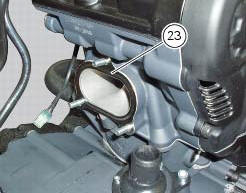
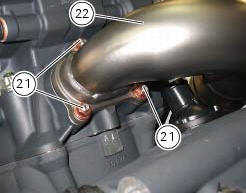
If removed, tighten the vertical lambda sensor (20) to a torque of 25 nm +/- 10% (sect. 3 - 3, Frame torque settings).
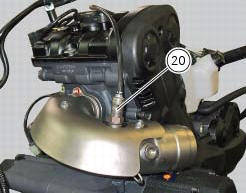
Position the horizontal exhaust manifold (24) on the horizontal cylinder head with the gasket (23).
Tighten the fixing nuts (21) to a torque of 10 nm +/- 10% (sect. 3 - 3, Frame torque settings).
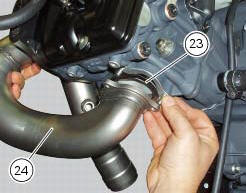
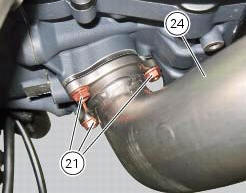
If removed, tighten the horizontal lambda sensor (20) to a torque of 25 nm +/- 10% (sect. 3 - 3, Frame torque settings).
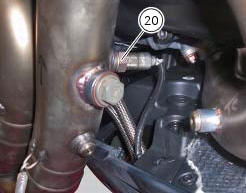
Check the presence of clips (15) on the upper exhaust pipe (19).
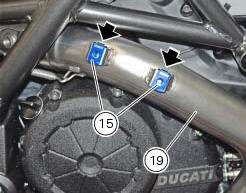
Fit the aramid washers (12) on the screws (11) using the recommended threadlocker.
Insert the screws (11) in the holes of the heat guard (13).
Insert the other two washers (12) and the spacers with collar (14) on the protruding ends of the screws (1).
Note
The two spacers (14) must be oriented with the collar (w) facing the heat guard (13) as shown.
Fit the heat guard (13) starting the screws (11) and tighten the screws (11) to the torque of 8 nm +/- 10% (sect. 3 - 3, Frame torque settings), making sure the washers (12) are centred to the collars (w) of the spacers (14).
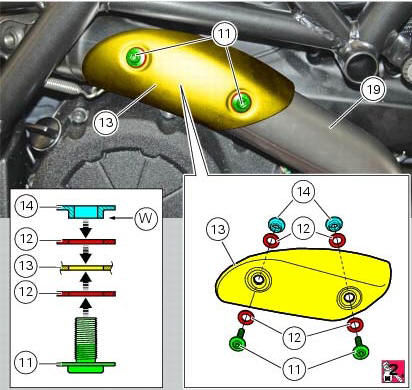
Insert the upper exhaust pipe (19) into the vertical exhaust pipe (22) and block it with the spring (16).
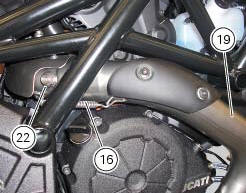
Insert the central exhaust pipe (26) in the upper exhaust pipe (19) and the horizontal flange (24), and fix them with the springs (16).
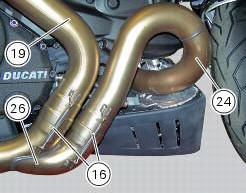
If the exhaust valve motor had been removed, fit the vibration dampers (35) into the suitable holes of the exhaust valve (34) on refitting. Fit the exhaust valve motor (34) and position it as shown on the cover (32), bringing its vibration dampers (35) fully home on the stud bolts (e).

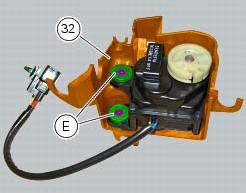
Fix the exhaust valve motor (34) to cover (32) starting the screws (37) with washers (36) in the vibration dampers (35) installed previously. Tighten the screws (37) to a torque of 3 nm +/- 10% (sect. 3 - 3, Frame torque settings).
Fit the vibration dampers (31) on the cover (32) at the positions shown.
Insert the spacers with collar (30) into the vibration dampers (31) as shown.
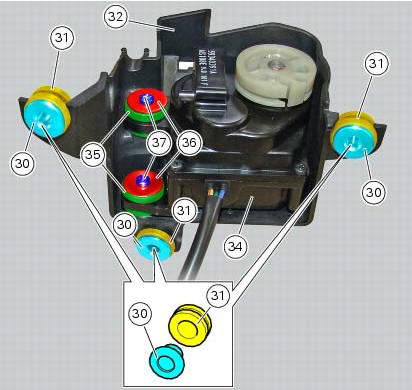
Fit the exhaust valve motor cable (m) inserting the end fitting (f) in the suitable hole of pulley (g).
Note
The exhaust valve motor cable (m) must be positioned above the wiring (h) of the exhaust valve motor (34).
Insert the cylindrical terminal (l) into the suitable seat of the exhaust valve motor (34) and make sure to bring it fully home.
Note
If it proves difficult to insert the terminal (l) fully home into its seat, apply lubricant for rubber to the terminal.
Tie the wiring (h) using a large self-locking tie wrap (n) in the area of the cover (32) shown.
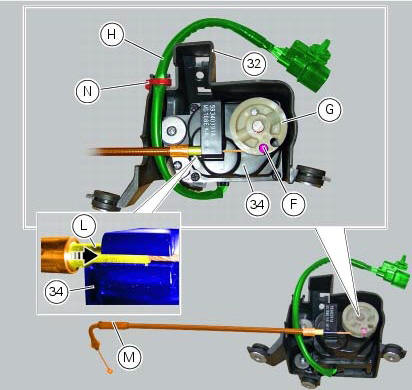
If previously removed, place the exhaust valve motor assembly (32) on the right plate of the rear subframe, start the screws (29) with washers (30) and tighten them to a torque of 10 nm +/- 10 % (sect. 3 - 3, Frame torque settings).
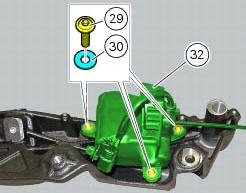
Position the control cable (25) in the plate (c).
Insert the end fitting (b) on the exhaust valve (d) and block it with the circlip (39).
Warning
Make sure the end fittings (b) at cable ends are properly fitted onto the pulleys of the exhaust valve and of its motor.
Check that the cylindrical terminal (l) is fully inserted (fully home) into the suitable seat of the exhaust valve motor.
After assembly, the cable (25) on exhaust valve and exhaust valve motor is adjusted automatically by dashboard software, that causes the valve to open fully at the first key-on, and then goes back to rest position with the valve fully closed.
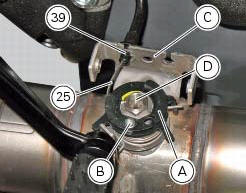
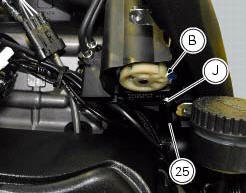
Refit the exhaust by-pass valve cover (27) by starting and tightening the screws (28) to a torque of 8 nm +/- 10% (sect. 3 - 3, Frame torque settings), starting with the front one.
Refit the silencer, as described in the paragraph "refitting the silencer" of this section.
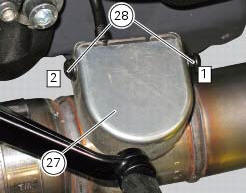
If removed, fit the copper washers (18) to the plugs (17), start the plugs into the vertical (22) and horizontal (24) head exhaust manifolds and tighten them to the torque of 25 nm +/- 10% (sect. 3 - 3, Frame torque settings).
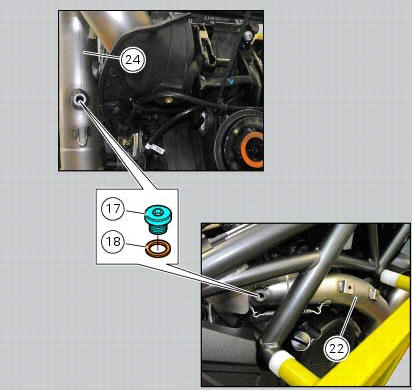
If the silencer heat guard had been removed, check the presence of clips (43) on the silencer (4).
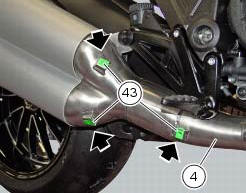
Important
Assembly operations described below must be performed following sequence x - y - z.
Fit the washers (12) on the screws (40).
Insert the screws (40) in the holes of the heat guard (41).
Insert the other three washers (12) and the spacers with collar (42) on the protruding ends of the screws (40).
note
The spacers (42) must be oriented with the collar (j) facing the heat guard (41) as shown.
Fit the heat guard (41) by starting the screws (40).
Tighten the screws (40) to a torque of 5 nm +/- 10% (sect. 3 - 3, Frame torque settings), following sequence z - x - y and making sure the washers (12) are centred to the collars (j) of the spacers (42).
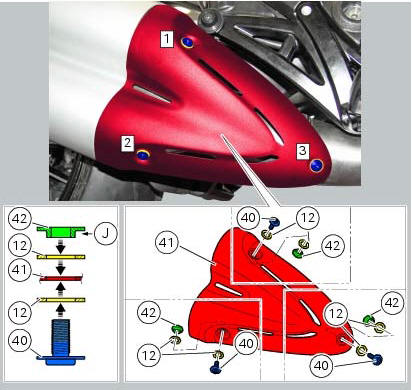
Check the presence of the rubber pad (46) on the heat guard (45).
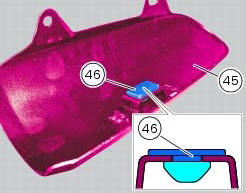
Fit the washers (12) on the screws (44) using the recommended threadlocker.
Insert the screws (44) in the holes of the rear heat guard (45).
Insert the other two washers (12) and the spacers with collar (47) on the protruding ends of the screws (44).
Note
The spacers (47) must be oriented with the collar (k) facing the heat guard (45).
Fit the heat guard (45) by starting the screws (44).
Tighten the screws (44) to a torque of 8 nm +/- 10% (sect. 3 - 3, Frame torque settings), making sure the washers (12) are centred to the collars (k) of the spacers (47).
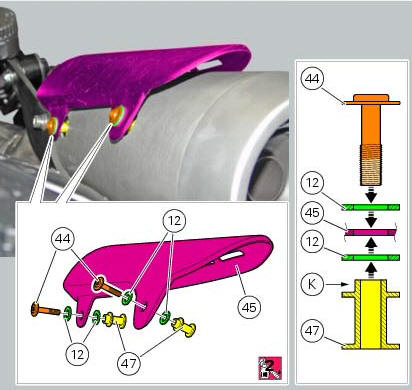
 Removal of the exhaust system
Removal of the exhaust system
Remove the silencer, as described in the paragraph "removing the silencer" of
this section.
Loosen the screws (28) and remove the exhaust by-pass valve cover (27).
Turn the exhaust valve pul ...
 Refitting the silencer
Refitting the silencer
Position the silencer guard (41) and fix it by starting the screws (40).
Tighten the screws (40) to a torque of 8 nm +/- 10% (sect. 3 - 3, Frame torque
settings).
Insert the silencer (4) int ...
Other materials:
Removal of the crankshaft/connecting rods assembly
After separating the crankcase halves, withdraw the crankshaft (6) complete
with connecting rods (2).
...
Adjusting the clutch lever and front brake lever
The clutch lever (1) is fitted with a span adjuster (2) which serves to alter
the distance of the lever from the handlebar.
The lever distance can be adjusted through 10 clicks of the dial (2). Turn
clockwise to increase lever distance. Turn the
adjuster counter clockwise to decrease lever d ...
Disassembling the water radiator unit
The procedure is the same for both radiators.
Loosen the screws (15), (21) and (25) to remove the air duct (24) from the right
radiator (13).
Undo the screws (12) and (14) to remove the half-fairing (23) from the
radiator.
Radiator inspection
Visually inspect the oil co ...